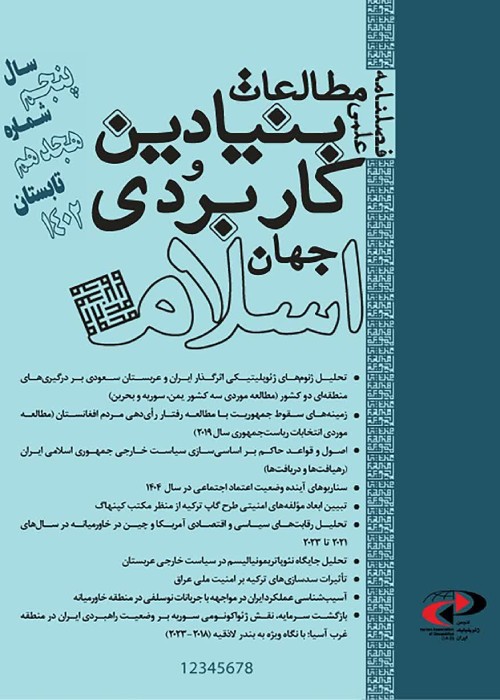Modeling the relations of regional powers in crush zone. Case study; Iran and Saudi Arabia in Southwest Asia
As a link between the three continents of the world, the West Asian geographic tape recorder has formed the geopolitical structure of specific regions that have acquired global strategic importance and is under the influence and domination of global and regional powers, and have experienced numerous actions and interactions. From a geographical point of view, the unique features of West Asia such as the connection of important seas, biological foundations and macro resources, energy, water crisis and hydro political issues, diversity of ethnicities and religions and cultures, features and geographical factors, etc. are in the process of structural change and the geopolitical order of this region has been effective and there have always been changing geopolitical coils in it.The present study aims to identify the pattern of relations between the regional powers of West Asia in the framework of the theory of the world system and the fragile regions of Seoul Cohen. The question of research is what factors affect the pattern of relations between regional powers in West Asia. The research hypothesis is that the conflict of geopolitical interests of the Islamic Republic of Iran and Saudi Arabia has led to the stability of the fragility of the region and has created a pattern of instability. The method of this research is descriptive and to deduce the discussion, the data and information required for the research have been collected from library documents and resources.The West Asian region has always witnessed many regional rivalries, but in the meantime, the rivalries between Iran and Saudi Arabia are of special importance due to their ideology and geopolitical reflections. Throughout history, Iran and Saudi Arabia have sought to increase their influence in the region, and the reflection of these relations for the region has been largely accompanied by competition and tension.The ups and downs of Iran-Saudi Arabia relations during the four decades after the victory of the Islamic Revolution in Iran, based on three levels of nature, behavior and positions, show that these relations have always been in an unstable state. The rise to power of Mohammad bin Salman, who played a key role in deciding to invade Yemen militarily, indicates a more aggressive approach to Iran. The basis of this policy is to prevent Iran from increasing its power in the region. In fact, Saudi foreign policy blames Iran for many of the West Asian region's political and security problems. The principles of this policy are the result of Saudi Arabia's strategic needs in the new situation in the region. The policy aims to remove Bashar al-Assad from Syria, curb Iran's nuclear program, prevent Iran from gaining power in the region, weaken Shiite militias in Iraq, Syria, Lebanon and Yemen and define them as terrorist groups, establish a Palestinian state, and work the global scale has been set up to destroy ISIS and al-Qaeda, Saudi Arabia's main strategy towards the region, especially the Islamic Republic of Iran. Iran is preventing the transformation of a regional multipolar order into a unipolar system centered on itself through balancing. The main principles and goals of Saudi Arabia's foreign policy, which are aimed at maintaining the security and national interests of this country, can be categorized into the five main axes of hegemony in the periphery or the Arabian Peninsula, regional balancing in West Asia, international coalition building and anti-democracy. In Riyadh's view, the 2006 war between Hezbollah and Israel shifted the regional balance in Iran's favor. Regional rivalries between Iran and Saudi Arabia have increased significantly in recent years in sensitive regions, in other words, sensitive states, including Palestine, Lebanon, Syria, Iraq, Bahrain and Yemen, to protect regional allies and create insecurity in the regions. Outsiders are considered as the main strategies of the parties.The study showed that during the four decades after the Islamic Revolution in Iran, conflicting and tense geopolitical interests have led the two countries of Iran and Saudi Arabia to increasing competition and confrontation. However, the two countries have the capacity and grounds to establish interactive relations. However, the current situation in the region is such that basically any territorial approach will face costly and deadlocked tensions and there is no prospect of hegemony in West Asia. Costs will pave the way for wider intervention by supra-regional powers in regional relations. The two countries have the ability to redirect interactions based on shared interests and use existing capacities to cooperate and assist in regional security management.
- حق عضویت دریافتی صرف حمایت از نشریات عضو و نگهداری، تکمیل و توسعه مگیران میشود.
- پرداخت حق اشتراک و دانلود مقالات اجازه بازنشر آن در سایر رسانههای چاپی و دیجیتال را به کاربر نمیدهد.


